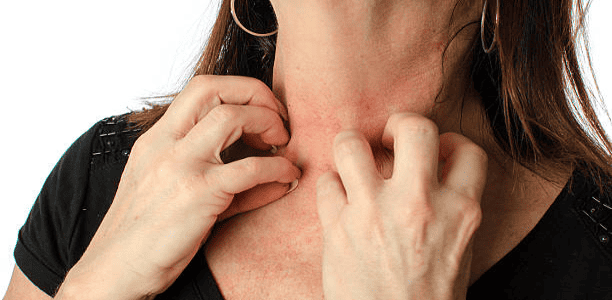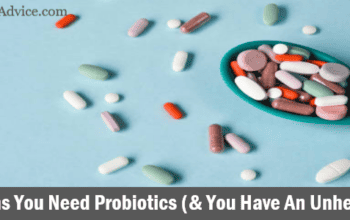
Let's talk about the top 4 side effects of probiotics.
But most importantly – how should you avoid them and make sure you stay on the safe side?
And there's a lot more to talk about:
- how to take probiotics correctly
- some tips to avoid these adverse effects
If you're trying to keep your probiotic routine on the safe side, don't skip the following lines!
Note: This article includes references and studies on Probiotics.
4 Side Effects Of Probiotics (In A Nutshell)
Firstly, probiotics are live microorganisms that promote a healthy gut microbiome.
In general – they are considered safe and beneficial.
However, in some instances, probiotics can also cause specific adverse reactions:
- digestive discomfort
- allergy/allergic reactions
- high risk of infections
- increased histamine levels
Now – those side effects above are the most common ones.
But there are ways to minimize them and let me give you some tips:
- Find the right strains and start with a low dose (before gradually increasing it).
- Go for high-quality and reputable products.
- Check the label to avoid allergens and high histamine triggers.
- Consult a doctor if you have certain health conditions.
Again – if you're only looking for maintenance, it's safe to start with 5 billion CFU (10 billion at most).
But if your body requires a higher dose, stick to it for 1-3 months only.
Overall – always remember that gut microbiome is not the same for everyone.
So it's better to monitor your progress and symptoms to find the product that works for you.
But if you're someone with underlying health issues, working with a doctor is a must.
Again – probiotics are safe in general, as long as you take them properly.
How To Take Probiotics Correctly
Unlike probiotics, probiotics are good bacteria that make the gut microbiome healthy [1].
Usually – they are incorporated into different products you can find in the market.
These products are usually very versatile (supplements, fermented foods, yogurt and drinks).
Also – there are 7 main strains available in most products [2]:
- Lactobacillus
- Bifidobacterium
- Saccharomyces
- Streptococcus
- Enterococcus
- Escherichia
- Bacillus
Now, let's move on to the main topic of this chapter.
I will give you the basic steps on how you should take probiotics correctly:
- Identify your symptoms.
- Choose the right product and probiotic strains.
- Follow the dosage instructions correctly.
- Try taking them before or after a meal .
- Take probiotics consistently or at the same time period every day.
- Store your probiotic products properly to avoid killing the live microorganisms.
- Track your results/progress to check if it's working for you.
- If you see any positive results, you may switch to a maintenance dose.
However – if you have a more serious case of digestive issues, these steps might not work.
It's safer to consult a doctor than to experiment with probiotics yourself.
In this way, you would get the right intervention for your health problems.
In general – probiotics have a lot of benefits and are considered safe.
But some people may still experience a few adverse reactions.
With that, let's discuss below the top 4 most common potential side effects of probiotics.
#1 – Digestive Discomfort
Digestive problems are the most usual adverse reactions you can experience.
To be exact – here are the symptoms you might notice [3]:
- constipation
- bloating
- gas and abdominal pain
- diarrhea
- heartburn
Now – there's one major reason why digestive discomfort appears if you take probiotics.
It's because you're introducing a new set of good bacteria in your stomach.
They can disrupt the balance of your current gut microbiome.
Here are some tips to help you avoid that:
- start by choosing a low dose of probiotics
- gradually increase the dose once your gut adjusts
- drink a lot of water to promote the balance of gut bacteria
- you may opt to take your probiotics after a meal
- find the right strain that works best for you
Ideally – probiotics work best before eating [4].
If you're familiar with supplements, they also recommend you to take them before meals.
But their effect is the same even if you take them afterward.
Instead, you may notice that you can tolerate them better on a full stomach.
So just find the right schedule and strain that will not cause you any discomfort.
#2 – Allergic Reactions
Again – probiotics are considered safe most of the time.
However, they can still cause allergic reactions rarely:
- they may contain hidden food allergens [5]
- additives and contaminants are also present in some products
- you may have an allergy to specific bacteria strains [6]
How would you recognize an allergic reaction?
Well – you would be experiencing itching, rashes, hives, swelling or even difficulty breathing.
In order to avoid allergic reactions, here's what you can do:
- Choose a high-quality product from reputable brands.
- Check the label to make sure it doesn't contain a strain/ingredient you're allergic to.
- Start with a low dose to allow your body to adjust.
- Always double-check the product's expiration date.
- You can also start your journey with probiotics by eating fermented foods.
- Monitor your symptoms to track the triggers of your allergies.
In addition, you can also consult a doctor (especially if you have a history of allergies).
Also – seeking a medical expert is important if you're taking other medications or supplements.
In this way, you can make sure there are no interactions between them.
But even so – less than 1% of people taking probiotics experience any allergic reaction to them.
So you would probably be fine taking any probiotic supplement.
#3 – Risk Of Developing Infections
Another potential side effect of taking probiotics is developing an infection.
Here are some of the reasons why [7]:
- unregulated probiotic products might contain infectious contaminants
- overgrowth of harmful bacteria (if your product contains an unknown strain)
Most of the time, immunocompromised individuals experience infections.
This could happen if you're undergoing treatments like chemotherapy or taking cortisol.
If that's your case, it's very important that you consult your doctor first.
However – here are the tips to avoid infections:
- Always choose high-quality products.
- Handle the product carefully to ensure that its live bacteria remain intact.
- Be cautious in trying products (especially if you have a history of allergies).
- Monitor your side effects.
- Seek medical help immediately if anything happens.
In addition, stick to your preferred schedule of taking your probiotics and don't overdose on them.
That's because inconsistencies and overdosing can alter your gut microbiome.
Always remember that not all probiotics are beneficial to everyone.
So if you're not sure, there's no harm in seeking help from medical experts.
#4 – High Histamine Levels
Lastly – some probiotic strains can also cause high histamine levels (though very rarely).
This happens when the bacteria affect the allergy-related histamine signaling [8].
In this case, the histamine levels in your stomach will rise, causing a build-up in your gut.
People who can't tolerate histamine can be greatly affected by this side effect.
To clarify, histamine intolerance means that you don't have enough enzymes to metabolize histamine [9].
The lack of the enzyme Diamine Oxidase (DAO) can be due to existing gut problems or genetics [10] [11].
With that, here are the symptoms of a high histamine level [12]:
- allergic-like reactions
- headache
- diarrhea
- asthma
- arrhythmia
- flushing
- hypotension
Now – there are several steps to avoid high histamine when taking probiotics:
- Choose products with low histamine levels (often labeled as “low-histamine”).
- Take a supplement that will boost the functions of DAO enzymes (that metabolize histamine).
- Start with a slow introduction of probiotics.
- Don't eat foods that are high in histamine, to avoid worsening the symptoms.
- Focus on eating nutrient-dense foods (that are rich in fiber).
- Avoid NSAIDs and alcohols, since they can block DAO. [13]
But again, the points above are just precautionary tips.
So if you have a serious case of histamine intolerance, it's best to talk to a doctor first.
Again – probiotics are safe in most cases, but they should be taken correctly.
How To Avoid Side Effects
So how could you avoid the 4 potential major side effects above?
Well – here are the top things to remember before taking probiotics:
- it's always better to start with low-dose probiotics
- choose high-quality products from reputable brands
- find the strains with studies about their safety and efficacy
- allow your body to adjust before gradually increasing the dose
- always check the label to avoid allergens
- opt for products that are low in histamines
In addition, you can only take high-dose probiotics when you really need them.
It's because taking a strong product when your body doesn't require it could lead to some health risks.
It's better to choose products with under 5 billion CFU (or up to 10 billion CFU).
Those numbers are considered safe even if you're only looking for maintenance.
Now – you might opt to take higher doses to address your symptoms and gut issues.
However, it's best to do that for 1-3 months (depending on the severity of your problems).
Overall – probiotics work best if you partner them with a healthy lifestyle.
Also, I highly suggest you to follow a balanced diet to keep your gut microbiome healthy.
Final Conclusion
To summarize, probiotics are safe in general.
But they can also cause side effects in some individuals.

- digestive problems
- allergic reactions
- developing infections
- increased levels of histamine
But you can always avoid them by taking probiotics carefully.
It's by finding the right strains, starting with low doses, checking the label and choosing high-quality products.
As I mentioned, don't take high doses if you don't really need them.
Just stick to 5-10 billion CFU if you're just looking to maintain healthy digestion.
Again – all of us have a unique gut microbiome.
So what works for others might not work for you.
With that, it always comes in handy to monitor your symptoms and track your progress.
The reason is to help yourself determine the possible triggers and to find the best routine for you.
References:
1 – https://www.ncbi.nlm.nih.gov/-books/-NBK553134/
2 – https://ods.od.nih.gov/-factsheets/-Probiotics/
3 – https://pubmed.ncbi.nlm.nih.gov/-28176047/
4 – https://pubmed.ncbi.nlm.nih.gov/-22146689/
5 – https://pubmed.ncbi.nlm.nih.gov/-22957765/
6 – https://pubmed.ncbi.nlm.nih.gov/-19663138/
7 – https://www.nccih.nih.gov/-health/-probiotics-what-you-need-to-know/
8 – https://pubmed.ncbi.nlm.nih.gov/-18544899/
9 – https://www.ncbi.nlm.nih.gov/-pmc/articles/-PMC7463562/
10 – https://www.allergyuk.org/-resources/-histamine-intolerance/
11 – https://www.ncbi.nlm.nih.gov/-pmc/articles/-PMC7463562/
12 – https://academic.oup.com/-ajcn/article/85/5/1185/-4633007/
13 – https://www.ncbi.nlm.nih.gov/-pmc/articles/-PMC8308327/
















